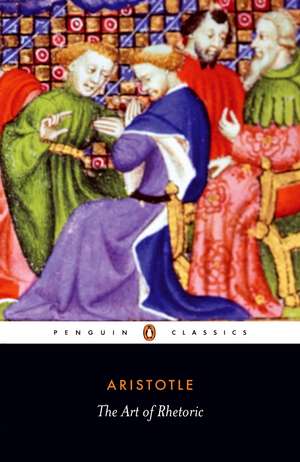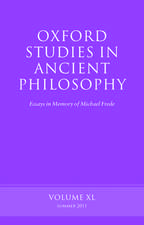The Art of Rhetoric
Autor Aristotleen Limba Engleză Paperback – 30 oct 1991
For more than seventy years, Penguin has been the leading publisher of classic literature in the English-speaking world. With more than 1,700 titles, Penguin Classics represents a global bookshelf of the best works throughout history and across genres and disciplines. Readers trust the series to provide authoritative texts enhanced by introductions and notes by distinguished scholars and contemporary authors, as well as up-to-date translations by award-winning translators.
Preț: 69.73 lei
Nou
13.34€ • 13.93$ • 11.04£
Carte disponibilă
Livrare economică 15-29 martie
Livrare express 01-07 martie pentru 19.50 lei
Specificații
ISBN-10: 0140445102
Pagini: 304
Dimensiuni: 129 x 198 x 17 mm
Greutate: 0.23 kg
Editura: Penguin Books
Colecția Penguin Classics
Locul publicării:London, United Kingdom
Notă biografică
HUGH LAWSON-TANCRED was born in 1955 and educated at Eton and Balliol College, Oxford. He is a Departmental Fellow in the Department of Philosophy at Birkbeck College in the University of London. He has published extensively on Aristotle and Plato and is currently engaged in research in computational linguistics. He translates widely from the Slavonic and Scandinavian languages. He is married with a daughter and two sons and lives in North London and Somerset.
Cuprins
Preface Introduction: 1. The Importance of Ancient Rhetoric 2. The Historical Background to the Rhetoric 3. Rhetoric as Techne 4. Psychology in the Rhetoric 5. Style and Composition 6. The Rhetorical Legacy of Aristotle 7. The Translation
THE ART OF RHETORICSection One: Introductory Chapter 1.1. The Nature of Rhetoric PART ONE: DEMONSTRATIONSection Two: The Genres of Oratory Chapter 1.2. The Definition of Rhetoric Chapter 1.3. The Genres Section Three: Deliberation Chapter 1.4. The Province of Deliberation Chapter 1.5. Happiness Chapter 1.6. The Good and the Expedient Chapter 1.7. Relative Expediency Chapter 1.8. Constitutions Section Four: Display Chapter 1.9. Display Oratory Section Five: Litigation Chapter 1.10. Injustice Chapter 1.11. Pleasure Chapter 1.12. The Criminal Mind Chapter 1.13. Crime and Punishment Chapter 1.14. Relatively Serious Crimes Chapter 1.15. Non-technical Proofs PART TWO: EMOTION AND CHARACTERSection Six: Emotion Chapter 2.1. The Role of Emotion and Character Chapter 2.2. Anger Chapter 2.3. Calm Chapter 2.4. Friendship and Enmity Chapter 2.5. Fear and Confidence Chapter 2.6. Shame Chapter 2.7. Favour Chapter 2.8. Pity Chapter 2.9. Indignation Chapter 2.10. Envy Chapter 2.11. Jealousy Section Seven: Character Chapter 2.12. Youth Chapter 2.13. Old Age Chapter 2.14. Prime Chapter 2.15. Birth Chapter 2.16. Wealth Chapter 2.17. Power PART THREE: UNIVERSAL ASPECTSSection Eight: Common Topics Chapter 2.18. The Role of Common Topics Chapter 2.19. The Topics of Possibility Chapter 2.20. Example Chapter 2.21. Maxim Chapter 2.22. Enthymeme Chapter 2.23. Demonstrative Common Topics Chapter 2.24. Illusory Topics Chapter 2.25. Refutation Chapter 2.26. Amplification Section Nine: Style Chapter 3.1. Historical Preliminary Chapter 3.2. Clarity Chapter 3.3. Frigidity Chapter 3.4. Simile Chapter 3.5. Purity Chapter 3.6. Amplitude Chapter 3.7. Propriety Chapter 3.8. Rhythm Chapter 3.9. Syntax Chapter 3.10. Wit and Metaphor Chapter 3.11. Vividness Chapter 3.12. Suitability to Genre Section Ten: Composition Chapter 3.13. Narration and Proof Chapter 3.14. The Introduction Chapter 3.15. Prejudice Chapter 3.16. Narration Chapter 3.17. Proof and Refutation Chapter 3.18. Altercation Chapter 3.19. The Epilogue Notes Bibliography















